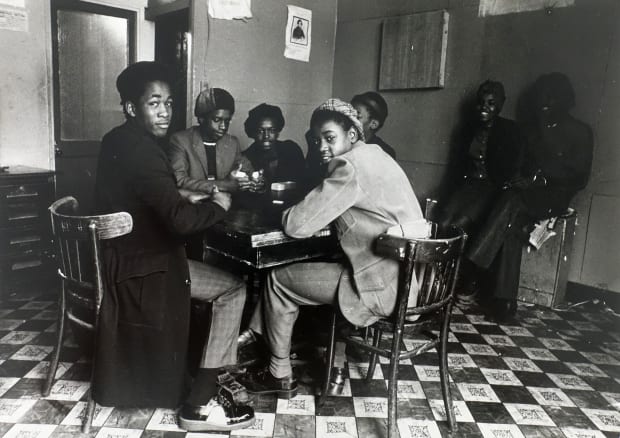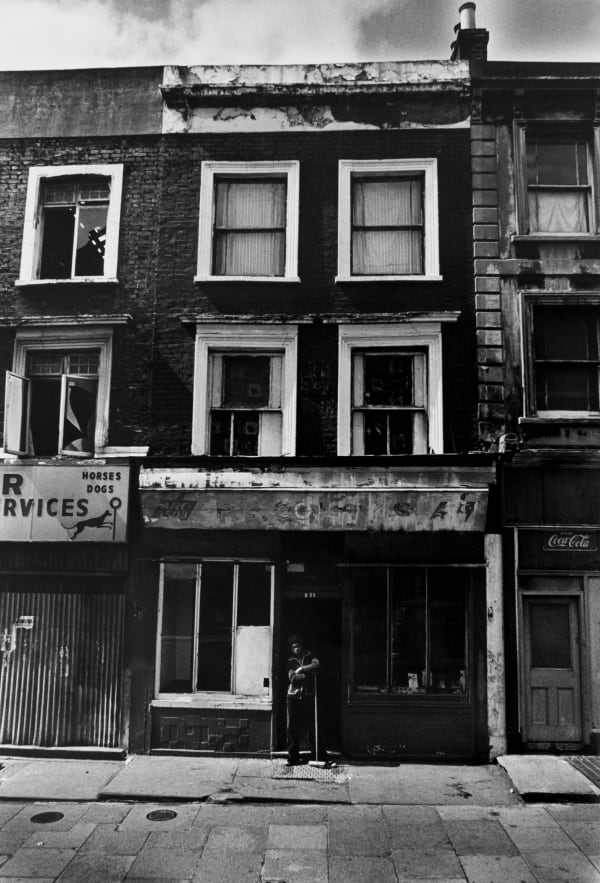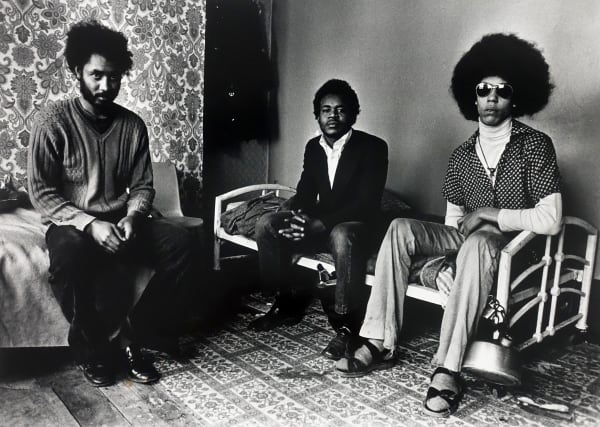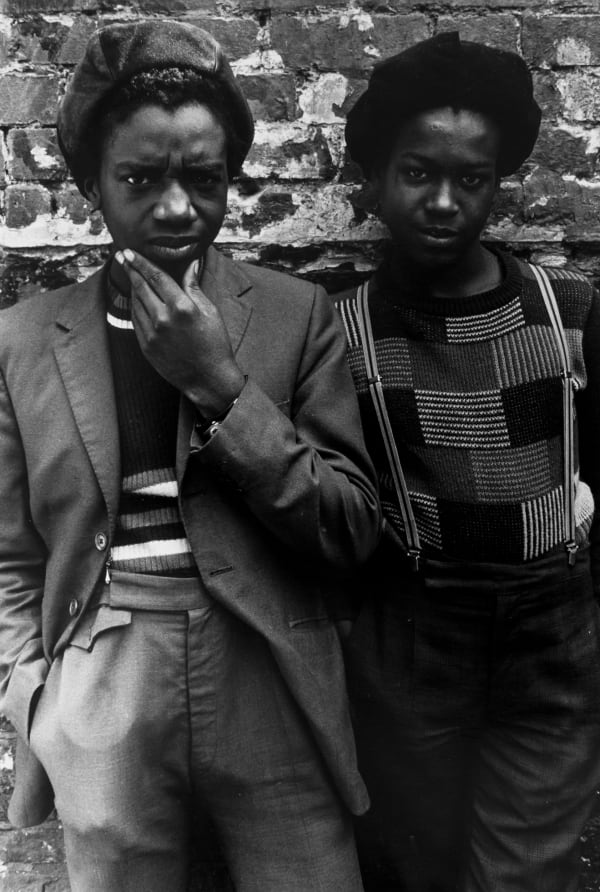"Of all my work, I am most proud of The Black House" - Colin Jones
This week we spoke to British photographer Colin Jones about the images he took of The Black House, a hostel for black youth in Holloway Road, North London. These pictures were originally commissioned by the Sunday Times in 1973, but Jones was invited back by residents and he continued to document their lives for the rest of the decade.
Born in London in 1936, Colin Jones's photographic career followed an unusual trajectory. He grew up in a working-class family in London’s East End, before winning a scholarship to train and later dance with The Royal Ballet.
-

Colin Jones, Self Portrait, 1958.
Taken in the Empire Theatre, Sydney, on The Royal Ballet tour of Australia and New Zealand. -
Colin Jones talks to Michael Hoppen about The Black House
July 2020 -
THE BLACK HOUSE
-
The Black House was founded by Herman Edwards, a charismatic Caribbean immigrant, better known to his community as Brother Herman. The hostel aimed to provide accommodation and support for disillusioned black adolescents, many of whom had experienced prejudice, unemployment, and problems with the police.
During the 1970s pressures created by inadequate housing, widespread unemployment, and hostility towards migrants, meant that many black teenagers found themselves with nowhere to live. Some were abandoned or thrown out by their families, whilst others left difficult domestic situations and struggled to find accommodation on their own. Many had left school with few or no qualifications and had passed in and out of the criminal justice system.
"I notice that a lot of boys are fascinated by the Black Power movement. They also talk a lot about home, family, identity. That's what Brother Herman is trying to do - help these young people to find and know themselves". - Colin Jones
-
 Colin JonesThe Black House, London, 1973-1976Vintage silver gelatin print40 x 50 cmSigned, titled and dated in pencil on verso. Artist's wet stamp on verso. Artist's embossed stamp on recto.
Colin JonesThe Black House, London, 1973-1976Vintage silver gelatin print40 x 50 cmSigned, titled and dated in pencil on verso. Artist's wet stamp on verso. Artist's embossed stamp on recto.
Print Date: 1973-1976 -
“Initially [Herman] didn’t want us, but in the end he let us in,” Jones, now 83, says. “They [the youngsters] were also very suspicious,” he said. “It was a time when the police were very anti-Black. But after a bit I got to know the people who lived there and with some I got on very well.”
Jones developed a complex and compelling bond with the residents of The Black House, and regularly revisited Holloway Road until 1976. After local authority subsidies for the hostel ran out, Jones stayed in touch with many of the residents. He was invited to photograph their weddings, funerals, and other important occasions for decades to come. The resultant series of images still attracts interest almost half a century later.
-
“I felt it was such a good thing to do that I carried on going up there in my Volkswagen camper van,” he says. “Sometimes I used to go in there and not take any pictures because the atmosphere was too tense. In the end I was picking up the kids to and from the court. I still see a couple of them.”
-
 Colin JonesThe Black House, Holloway Road, London, 1976Vintage silver gelatin printPaper Size: 17.2 x 25.4 cmSigned, titled and dated in pencil with artist's wet stamp on verso.
Colin JonesThe Black House, Holloway Road, London, 1976Vintage silver gelatin printPaper Size: 17.2 x 25.4 cmSigned, titled and dated in pencil with artist's wet stamp on verso. -
 Colin JonesThe Black House, London, 1973-1976Vintage silver gelatin printPaper size: 30.5 x 38 cmSigned, titled and dated in pencil with artist's wet stamp verso; artist's blind stamp recto
Colin JonesThe Black House, London, 1973-1976Vintage silver gelatin printPaper size: 30.5 x 38 cmSigned, titled and dated in pencil with artist's wet stamp verso; artist's blind stamp recto -
“When that picture was taken, I was about a year old. My mum moved from there to Tollington Road, into a bedsit! But she used to take me back to the Black House from time to time, so I remember the place. I had a picture of me on one of the roofs there. From Tollington Road we got a two bedroom flat in Hackney and my little brother was born. Sadly my mum passed away back in 2000, aged 43! I would say she had a good life! As for Country, I saw him about 2 years ago… He had a few kids, but he told me he had cancer.” - Dean Henry
-
EXHIBITION & LEGACY
-
The Black House photographs were displayed for the first time at The Photographer’s Gallery in 1977, where they became the subject of controversy. Critics complained that Jones was making money out of his photographs of this marginalized community, but he remained convinced that even when his position was uncomfortable, the importance of finishing the series was even more important.
-
 Colin JonesThe Black House, Holloway Road, London 1973 -1976Vintage silver gelatin print17.6 x 25.3 cmSigned, titled and dated in pencil with artist's wet stamp on verso.
Colin JonesThe Black House, Holloway Road, London 1973 -1976Vintage silver gelatin print17.6 x 25.3 cmSigned, titled and dated in pencil with artist's wet stamp on verso. -
The Black House series was published in a monograph in 2006 and a large group of prints was shown at Tate Britain in 2017 as part of Stan Firm Inna Inglan: Black Diaspora in London, 1960s-1970s
Colin Jones's photographs are a remarkable record of everyday life in the house. They also illustrate the social history at a very specific moment in 20th Century Britain. The series documents a community which only existed for a few years, but which speaks to the experience of many marginalized communties living in urban Britain during the 1970s.
When asked why he thinks that these photographs continue to attract interest, Jones says: “I knew that what I was doing, for a white person to get inside that place, was a privilege. It was like you found something that was unique and you stuck to it, and no other people had done it before”.
-
AVAILABLE WORKS
-














